Organisational Behaviour Report: 4Com Culture, Motivation, Teams
VerifiedAdded on 2020/12/30
|15
|4124
|309
Report
AI Summary
This report provides an analysis of organisational behaviour within the telecommunications company, 4Com. The report examines the influence of organisational culture, power dynamics, and political factors on individual and team behaviour and performance. It assesses various aspects of organisational culture including power structures, roles, and tasks, as well as the impact of politics. The report further evaluates content and process theories of motivation, such as Maslow's Hierarchy of Needs, Hertzberg's Two-Factor Theory, and Vroom's Expectancy Theory, to determine how these motivational techniques enable effective goal achievement. Finally, the report distinguishes between effective and ineffective teams, discussing the characteristics and dynamics that contribute to team success, and concludes with the application of Tuckman's theory to build effective teams within the 4Com context.
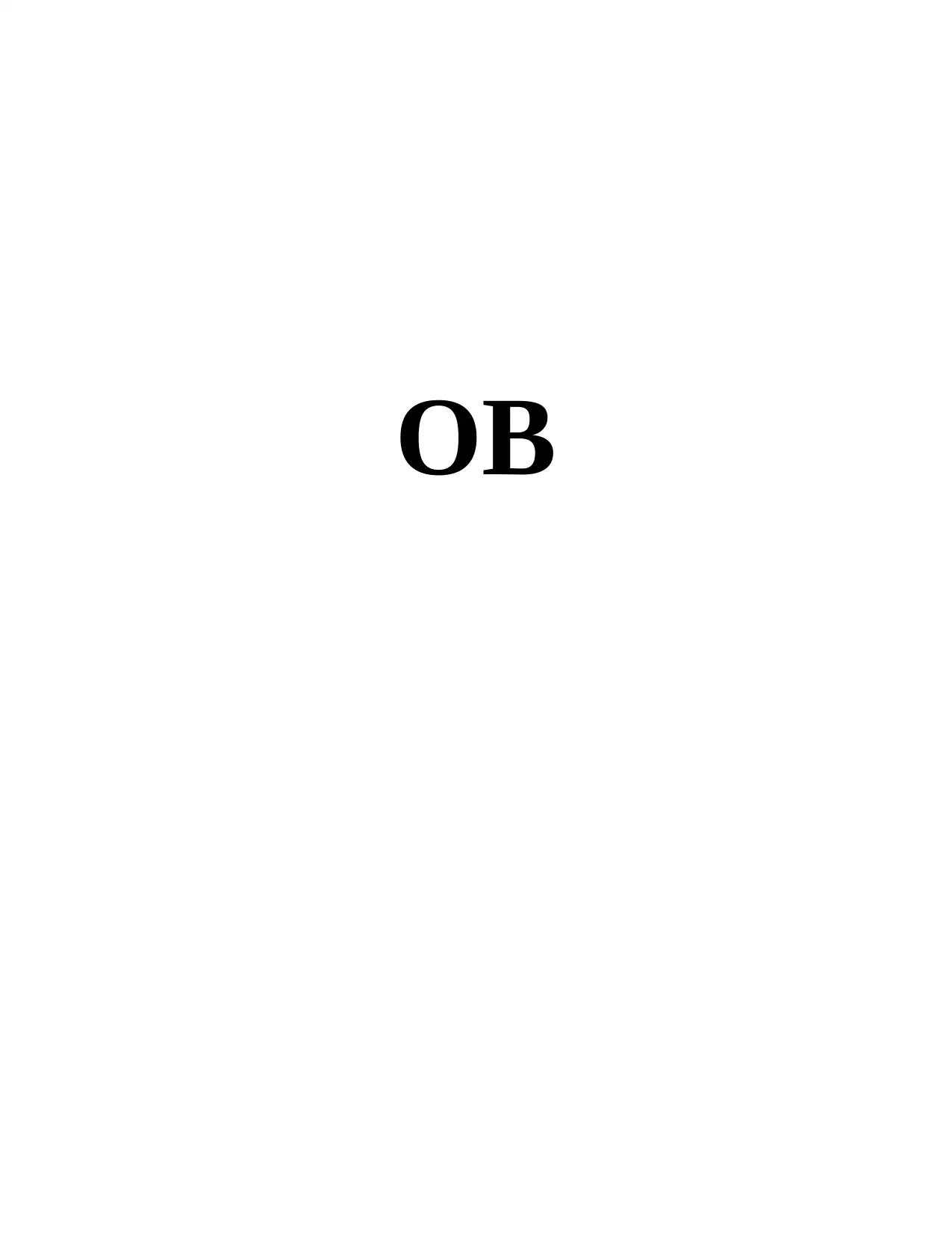
OB
Paraphrase This Document
Need a fresh take? Get an instant paraphrase of this document with our AI Paraphraser
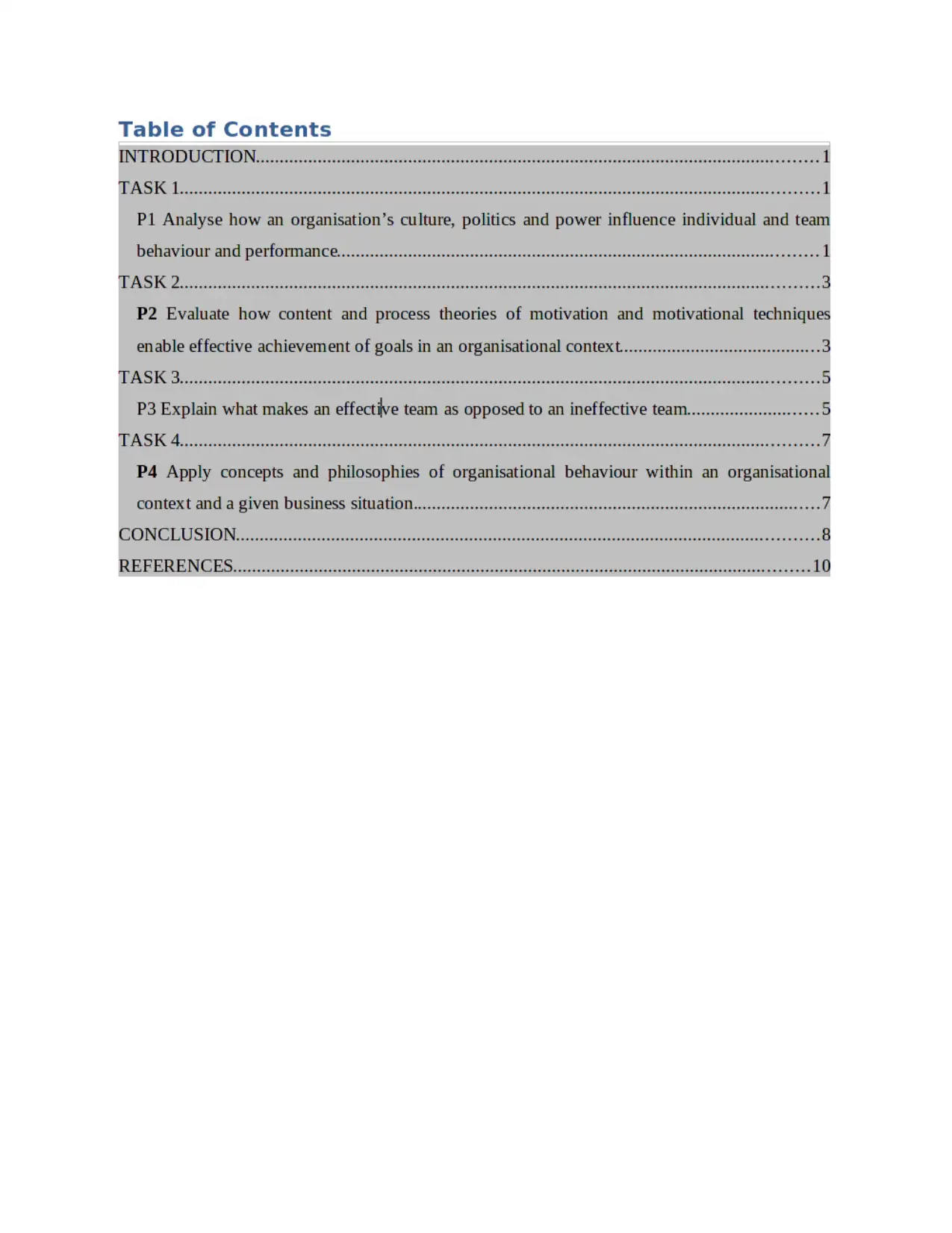

⊘ This is a preview!⊘
Do you want full access?
Subscribe today to unlock all pages.

Trusted by 1+ million students worldwide
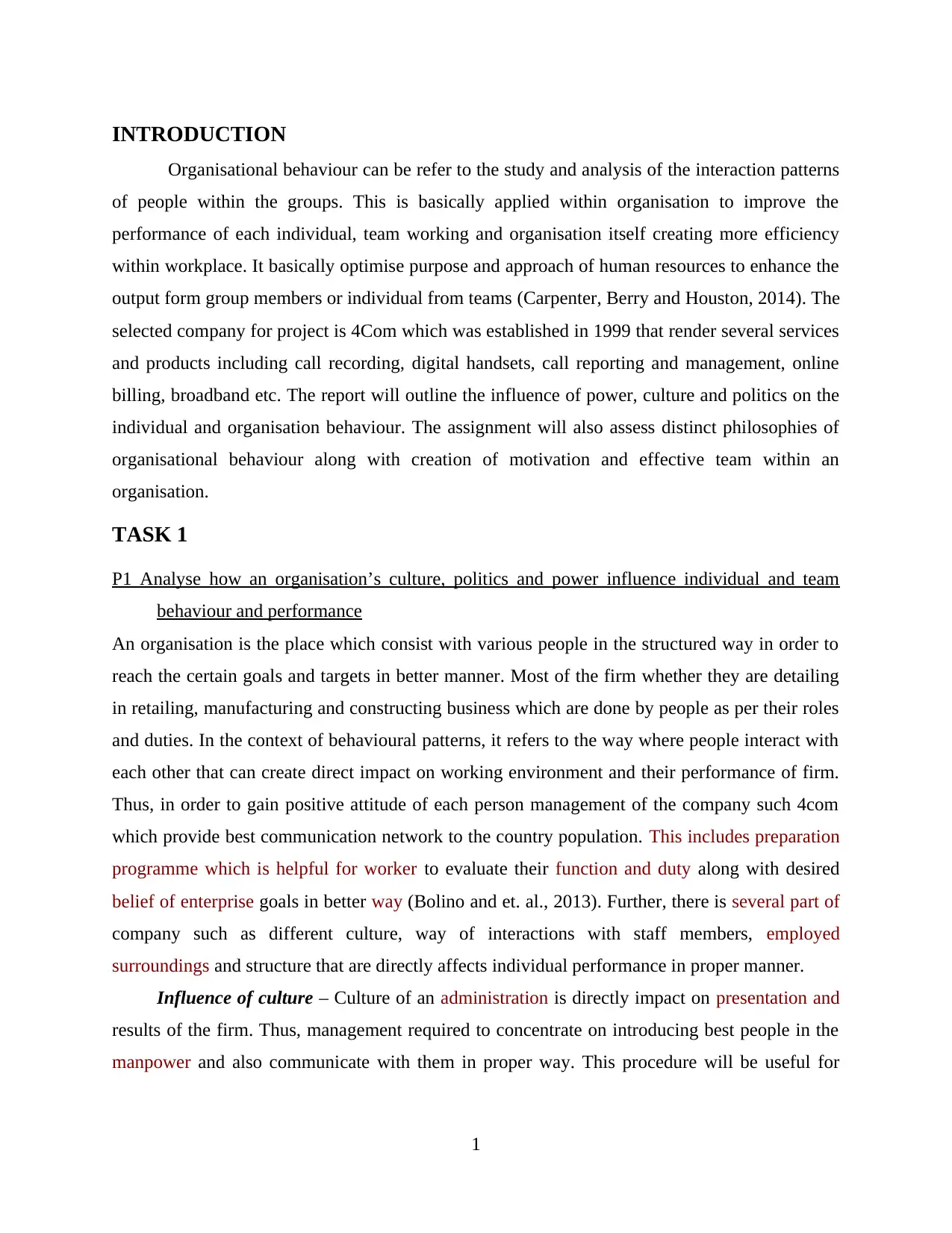
INTRODUCTION
Organisational behaviour can be refer to the study and analysis of the interaction patterns
of people within the groups. This is basically applied within organisation to improve the
performance of each individual, team working and organisation itself creating more efficiency
within workplace. It basically optimise purpose and approach of human resources to enhance the
output form group members or individual from teams (Carpenter, Berry and Houston, 2014). The
selected company for project is 4Com which was established in 1999 that render several services
and products including call recording, digital handsets, call reporting and management, online
billing, broadband etc. The report will outline the influence of power, culture and politics on the
individual and organisation behaviour. The assignment will also assess distinct philosophies of
organisational behaviour along with creation of motivation and effective team within an
organisation.
TASK 1
P1 Analyse how an organisation’s culture, politics and power influence individual and team
behaviour and performance
An organisation is the place which consist with various people in the structured way in order to
reach the certain goals and targets in better manner. Most of the firm whether they are detailing
in retailing, manufacturing and constructing business which are done by people as per their roles
and duties. In the context of behavioural patterns, it refers to the way where people interact with
each other that can create direct impact on working environment and their performance of firm.
Thus, in order to gain positive attitude of each person management of the company such 4com
which provide best communication network to the country population. This includes preparation
programme which is helpful for worker to evaluate their function and duty along with desired
belief of enterprise goals in better way (Bolino and et. al., 2013). Further, there is several part of
company such as different culture, way of interactions with staff members, employed
surroundings and structure that are directly affects individual performance in proper manner.
Influence of culture – Culture of an administration is directly impact on presentation and
results of the firm. Thus, management required to concentrate on introducing best people in the
manpower and also communicate with them in proper way. This procedure will be useful for
1
Organisational behaviour can be refer to the study and analysis of the interaction patterns
of people within the groups. This is basically applied within organisation to improve the
performance of each individual, team working and organisation itself creating more efficiency
within workplace. It basically optimise purpose and approach of human resources to enhance the
output form group members or individual from teams (Carpenter, Berry and Houston, 2014). The
selected company for project is 4Com which was established in 1999 that render several services
and products including call recording, digital handsets, call reporting and management, online
billing, broadband etc. The report will outline the influence of power, culture and politics on the
individual and organisation behaviour. The assignment will also assess distinct philosophies of
organisational behaviour along with creation of motivation and effective team within an
organisation.
TASK 1
P1 Analyse how an organisation’s culture, politics and power influence individual and team
behaviour and performance
An organisation is the place which consist with various people in the structured way in order to
reach the certain goals and targets in better manner. Most of the firm whether they are detailing
in retailing, manufacturing and constructing business which are done by people as per their roles
and duties. In the context of behavioural patterns, it refers to the way where people interact with
each other that can create direct impact on working environment and their performance of firm.
Thus, in order to gain positive attitude of each person management of the company such 4com
which provide best communication network to the country population. This includes preparation
programme which is helpful for worker to evaluate their function and duty along with desired
belief of enterprise goals in better way (Bolino and et. al., 2013). Further, there is several part of
company such as different culture, way of interactions with staff members, employed
surroundings and structure that are directly affects individual performance in proper manner.
Influence of culture – Culture of an administration is directly impact on presentation and
results of the firm. Thus, management required to concentrate on introducing best people in the
manpower and also communicate with them in proper way. This procedure will be useful for
1
Paraphrase This Document
Need a fresh take? Get an instant paraphrase of this document with our AI Paraphraser
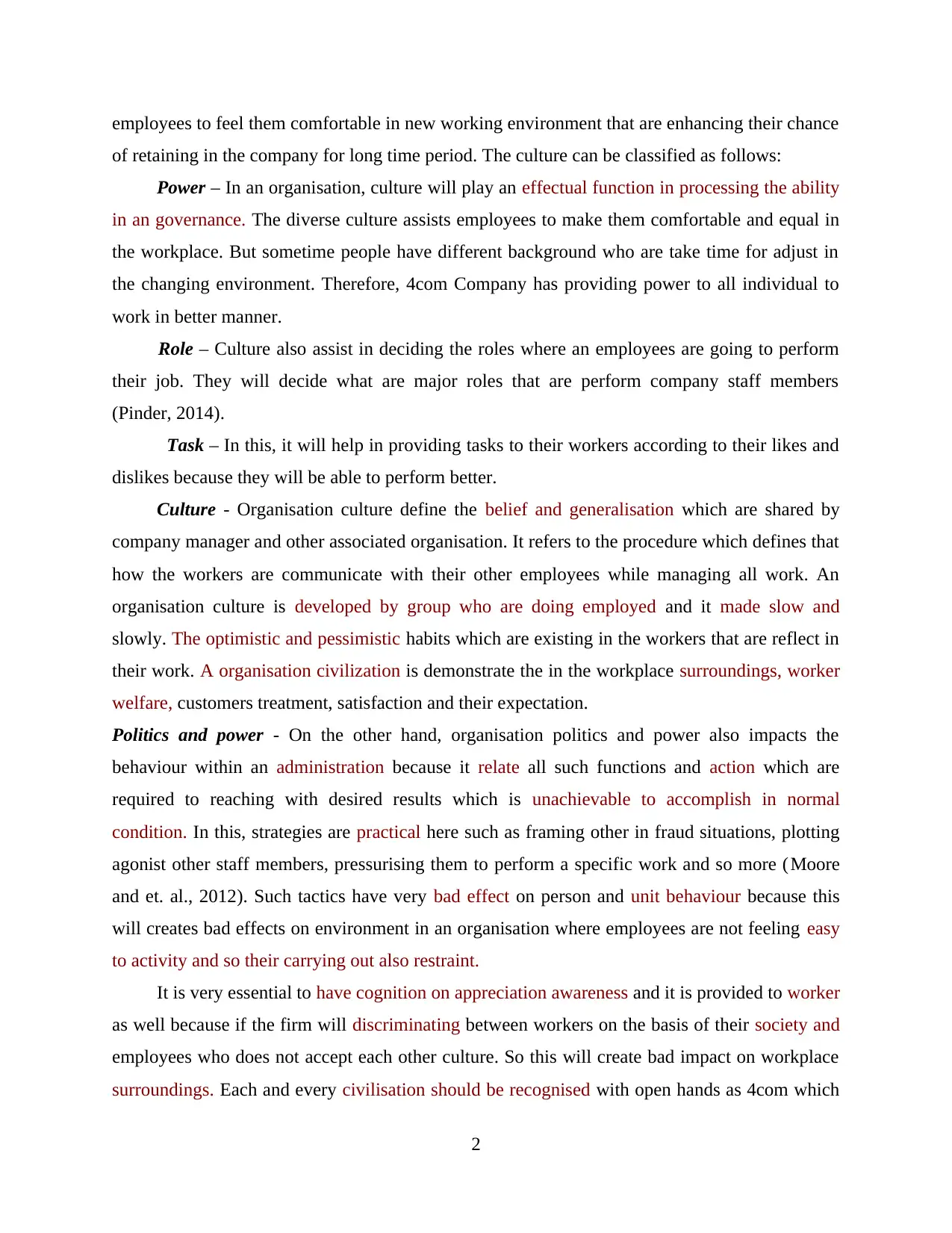
employees to feel them comfortable in new working environment that are enhancing their chance
of retaining in the company for long time period. The culture can be classified as follows:
Power – In an organisation, culture will play an effectual function in processing the ability
in an governance. The diverse culture assists employees to make them comfortable and equal in
the workplace. But sometime people have different background who are take time for adjust in
the changing environment. Therefore, 4com Company has providing power to all individual to
work in better manner.
Role – Culture also assist in deciding the roles where an employees are going to perform
their job. They will decide what are major roles that are perform company staff members
(Pinder, 2014).
Task – In this, it will help in providing tasks to their workers according to their likes and
dislikes because they will be able to perform better.
Culture - Organisation culture define the belief and generalisation which are shared by
company manager and other associated organisation. It refers to the procedure which defines that
how the workers are communicate with their other employees while managing all work. An
organisation culture is developed by group who are doing employed and it made slow and
slowly. The optimistic and pessimistic habits which are existing in the workers that are reflect in
their work. A organisation civilization is demonstrate the in the workplace surroundings, worker
welfare, customers treatment, satisfaction and their expectation.
Politics and power - On the other hand, organisation politics and power also impacts the
behaviour within an administration because it relate all such functions and action which are
required to reaching with desired results which is unachievable to accomplish in normal
condition. In this, strategies are practical here such as framing other in fraud situations, plotting
agonist other staff members, pressurising them to perform a specific work and so more (Moore
and et. al., 2012). Such tactics have very bad effect on person and unit behaviour because this
will creates bad effects on environment in an organisation where employees are not feeling easy
to activity and so their carrying out also restraint.
It is very essential to have cognition on appreciation awareness and it is provided to worker
as well because if the firm will discriminating between workers on the basis of their society and
employees who does not accept each other culture. So this will create bad impact on workplace
surroundings. Each and every civilisation should be recognised with open hands as 4com which
2
of retaining in the company for long time period. The culture can be classified as follows:
Power – In an organisation, culture will play an effectual function in processing the ability
in an governance. The diverse culture assists employees to make them comfortable and equal in
the workplace. But sometime people have different background who are take time for adjust in
the changing environment. Therefore, 4com Company has providing power to all individual to
work in better manner.
Role – Culture also assist in deciding the roles where an employees are going to perform
their job. They will decide what are major roles that are perform company staff members
(Pinder, 2014).
Task – In this, it will help in providing tasks to their workers according to their likes and
dislikes because they will be able to perform better.
Culture - Organisation culture define the belief and generalisation which are shared by
company manager and other associated organisation. It refers to the procedure which defines that
how the workers are communicate with their other employees while managing all work. An
organisation culture is developed by group who are doing employed and it made slow and
slowly. The optimistic and pessimistic habits which are existing in the workers that are reflect in
their work. A organisation civilization is demonstrate the in the workplace surroundings, worker
welfare, customers treatment, satisfaction and their expectation.
Politics and power - On the other hand, organisation politics and power also impacts the
behaviour within an administration because it relate all such functions and action which are
required to reaching with desired results which is unachievable to accomplish in normal
condition. In this, strategies are practical here such as framing other in fraud situations, plotting
agonist other staff members, pressurising them to perform a specific work and so more (Moore
and et. al., 2012). Such tactics have very bad effect on person and unit behaviour because this
will creates bad effects on environment in an organisation where employees are not feeling easy
to activity and so their carrying out also restraint.
It is very essential to have cognition on appreciation awareness and it is provided to worker
as well because if the firm will discriminating between workers on the basis of their society and
employees who does not accept each other culture. So this will create bad impact on workplace
surroundings. Each and every civilisation should be recognised with open hands as 4com which
2
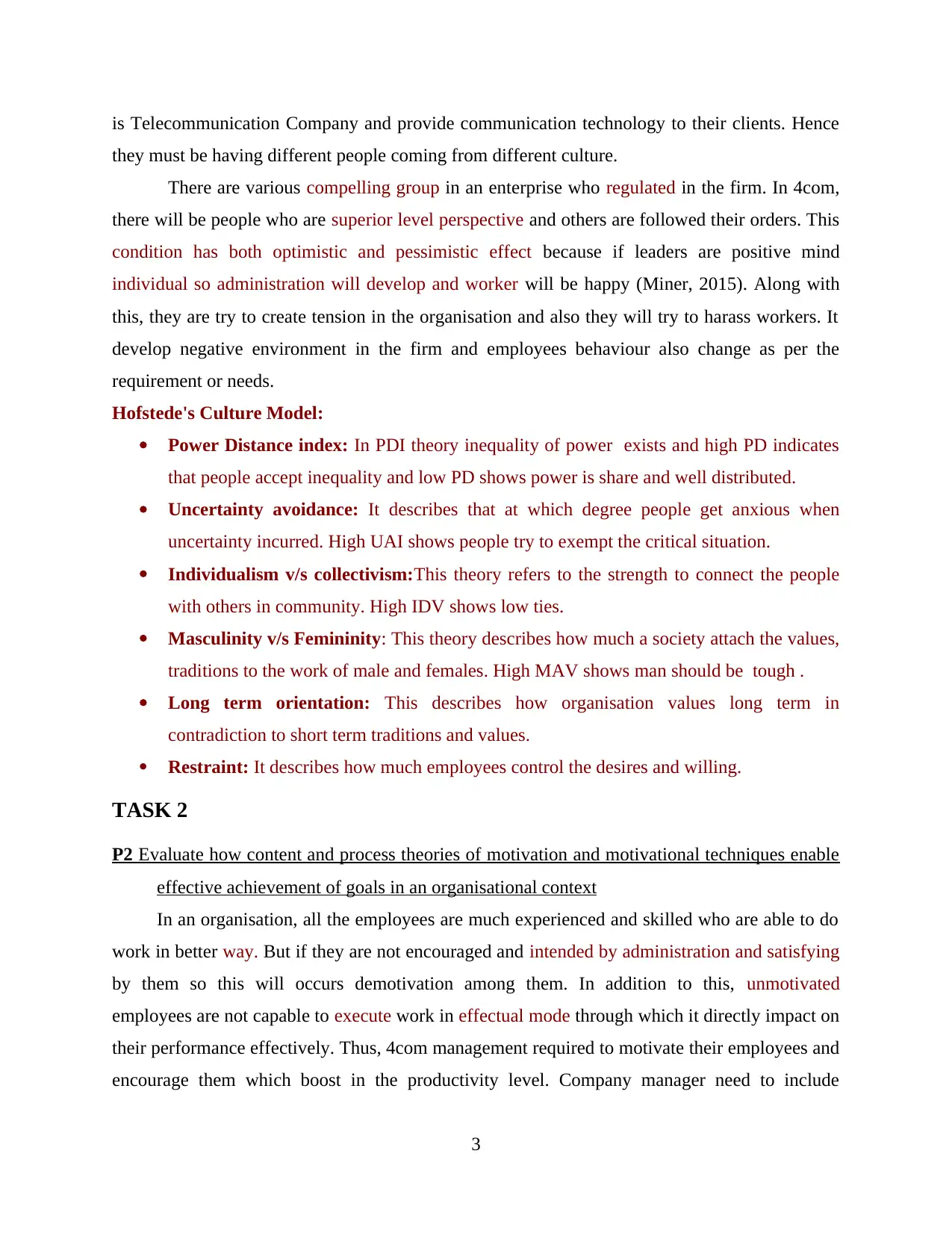
is Telecommunication Company and provide communication technology to their clients. Hence
they must be having different people coming from different culture.
There are various compelling group in an enterprise who regulated in the firm. In 4com,
there will be people who are superior level perspective and others are followed their orders. This
condition has both optimistic and pessimistic effect because if leaders are positive mind
individual so administration will develop and worker will be happy (Miner, 2015). Along with
this, they are try to create tension in the organisation and also they will try to harass workers. It
develop negative environment in the firm and employees behaviour also change as per the
requirement or needs.
Hofstede's Culture Model:
Power Distance index: In PDI theory inequality of power exists and high PD indicates
that people accept inequality and low PD shows power is share and well distributed.
Uncertainty avoidance: It describes that at which degree people get anxious when
uncertainty incurred. High UAI shows people try to exempt the critical situation.
Individualism v/s collectivism:This theory refers to the strength to connect the people
with others in community. High IDV shows low ties.
Masculinity v/s Femininity: This theory describes how much a society attach the values,
traditions to the work of male and females. High MAV shows man should be tough .
Long term orientation: This describes how organisation values long term in
contradiction to short term traditions and values.
Restraint: It describes how much employees control the desires and willing.
TASK 2
P2 Evaluate how content and process theories of motivation and motivational techniques enable
effective achievement of goals in an organisational context
In an organisation, all the employees are much experienced and skilled who are able to do
work in better way. But if they are not encouraged and intended by administration and satisfying
by them so this will occurs demotivation among them. In addition to this, unmotivated
employees are not capable to execute work in effectual mode through which it directly impact on
their performance effectively. Thus, 4com management required to motivate their employees and
encourage them which boost in the productivity level. Company manager need to include
3
they must be having different people coming from different culture.
There are various compelling group in an enterprise who regulated in the firm. In 4com,
there will be people who are superior level perspective and others are followed their orders. This
condition has both optimistic and pessimistic effect because if leaders are positive mind
individual so administration will develop and worker will be happy (Miner, 2015). Along with
this, they are try to create tension in the organisation and also they will try to harass workers. It
develop negative environment in the firm and employees behaviour also change as per the
requirement or needs.
Hofstede's Culture Model:
Power Distance index: In PDI theory inequality of power exists and high PD indicates
that people accept inequality and low PD shows power is share and well distributed.
Uncertainty avoidance: It describes that at which degree people get anxious when
uncertainty incurred. High UAI shows people try to exempt the critical situation.
Individualism v/s collectivism:This theory refers to the strength to connect the people
with others in community. High IDV shows low ties.
Masculinity v/s Femininity: This theory describes how much a society attach the values,
traditions to the work of male and females. High MAV shows man should be tough .
Long term orientation: This describes how organisation values long term in
contradiction to short term traditions and values.
Restraint: It describes how much employees control the desires and willing.
TASK 2
P2 Evaluate how content and process theories of motivation and motivational techniques enable
effective achievement of goals in an organisational context
In an organisation, all the employees are much experienced and skilled who are able to do
work in better way. But if they are not encouraged and intended by administration and satisfying
by them so this will occurs demotivation among them. In addition to this, unmotivated
employees are not capable to execute work in effectual mode through which it directly impact on
their performance effectively. Thus, 4com management required to motivate their employees and
encourage them which boost in the productivity level. Company manager need to include
3
⊘ This is a preview!⊘
Do you want full access?
Subscribe today to unlock all pages.

Trusted by 1+ million students worldwide
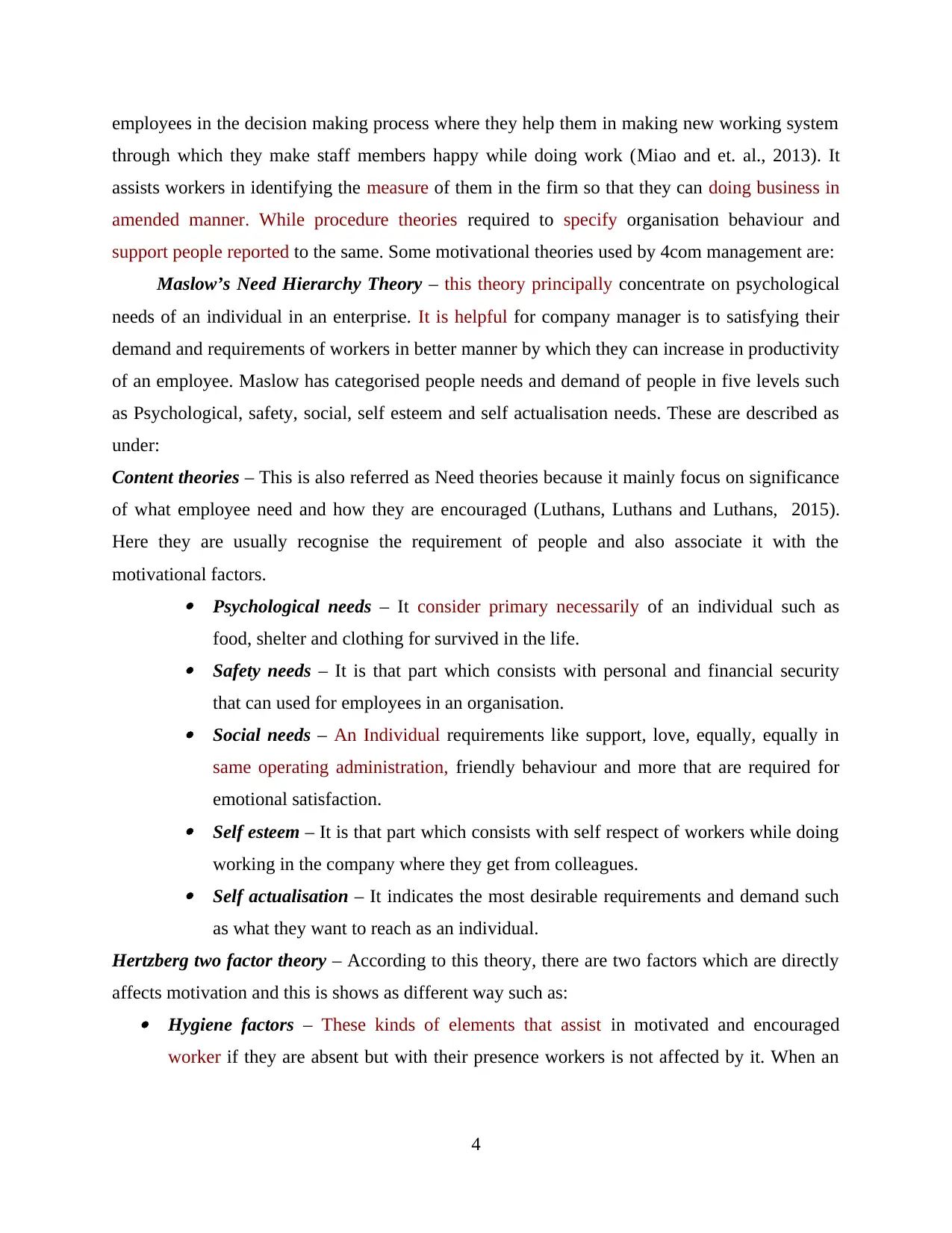
employees in the decision making process where they help them in making new working system
through which they make staff members happy while doing work (Miao and et. al., 2013). It
assists workers in identifying the measure of them in the firm so that they can doing business in
amended manner. While procedure theories required to specify organisation behaviour and
support people reported to the same. Some motivational theories used by 4com management are:
Maslow’s Need Hierarchy Theory – this theory principally concentrate on psychological
needs of an individual in an enterprise. It is helpful for company manager is to satisfying their
demand and requirements of workers in better manner by which they can increase in productivity
of an employee. Maslow has categorised people needs and demand of people in five levels such
as Psychological, safety, social, self esteem and self actualisation needs. These are described as
under:
Content theories – This is also referred as Need theories because it mainly focus on significance
of what employee need and how they are encouraged (Luthans, Luthans and Luthans, 2015).
Here they are usually recognise the requirement of people and also associate it with the
motivational factors.
Psychological needs – It consider primary necessarily of an individual such as
food, shelter and clothing for survived in the life.
Safety needs – It is that part which consists with personal and financial security
that can used for employees in an organisation.
Social needs – An Individual requirements like support, love, equally, equally in
same operating administration, friendly behaviour and more that are required for
emotional satisfaction.
Self esteem – It is that part which consists with self respect of workers while doing
working in the company where they get from colleagues.
Self actualisation – It indicates the most desirable requirements and demand such
as what they want to reach as an individual.
Hertzberg two factor theory – According to this theory, there are two factors which are directly
affects motivation and this is shows as different way such as: Hygiene factors – These kinds of elements that assist in motivated and encouraged
worker if they are absent but with their presence workers is not affected by it. When an
4
through which they make staff members happy while doing work (Miao and et. al., 2013). It
assists workers in identifying the measure of them in the firm so that they can doing business in
amended manner. While procedure theories required to specify organisation behaviour and
support people reported to the same. Some motivational theories used by 4com management are:
Maslow’s Need Hierarchy Theory – this theory principally concentrate on psychological
needs of an individual in an enterprise. It is helpful for company manager is to satisfying their
demand and requirements of workers in better manner by which they can increase in productivity
of an employee. Maslow has categorised people needs and demand of people in five levels such
as Psychological, safety, social, self esteem and self actualisation needs. These are described as
under:
Content theories – This is also referred as Need theories because it mainly focus on significance
of what employee need and how they are encouraged (Luthans, Luthans and Luthans, 2015).
Here they are usually recognise the requirement of people and also associate it with the
motivational factors.
Psychological needs – It consider primary necessarily of an individual such as
food, shelter and clothing for survived in the life.
Safety needs – It is that part which consists with personal and financial security
that can used for employees in an organisation.
Social needs – An Individual requirements like support, love, equally, equally in
same operating administration, friendly behaviour and more that are required for
emotional satisfaction.
Self esteem – It is that part which consists with self respect of workers while doing
working in the company where they get from colleagues.
Self actualisation – It indicates the most desirable requirements and demand such
as what they want to reach as an individual.
Hertzberg two factor theory – According to this theory, there are two factors which are directly
affects motivation and this is shows as different way such as: Hygiene factors – These kinds of elements that assist in motivated and encouraged
worker if they are absent but with their presence workers is not affected by it. When an
4
Paraphrase This Document
Need a fresh take? Get an instant paraphrase of this document with our AI Paraphraser
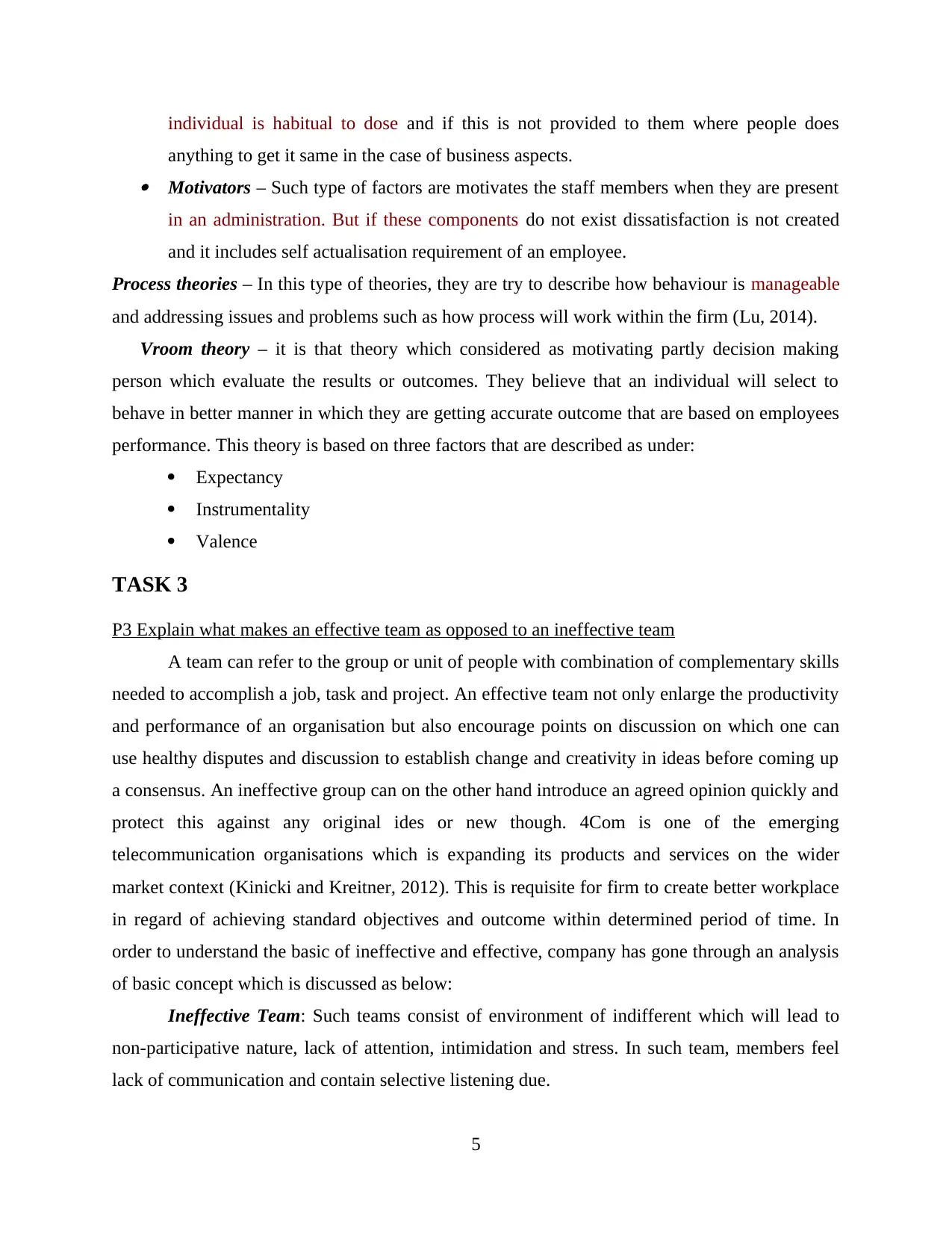
individual is habitual to dose and if this is not provided to them where people does
anything to get it same in the case of business aspects. Motivators – Such type of factors are motivates the staff members when they are present
in an administration. But if these components do not exist dissatisfaction is not created
and it includes self actualisation requirement of an employee.
Process theories – In this type of theories, they are try to describe how behaviour is manageable
and addressing issues and problems such as how process will work within the firm (Lu, 2014).
Vroom theory – it is that theory which considered as motivating partly decision making
person which evaluate the results or outcomes. They believe that an individual will select to
behave in better manner in which they are getting accurate outcome that are based on employees
performance. This theory is based on three factors that are described as under:
Expectancy
Instrumentality
Valence
TASK 3
P3 Explain what makes an effective team as opposed to an ineffective team
A team can refer to the group or unit of people with combination of complementary skills
needed to accomplish a job, task and project. An effective team not only enlarge the productivity
and performance of an organisation but also encourage points on discussion on which one can
use healthy disputes and discussion to establish change and creativity in ideas before coming up
a consensus. An ineffective group can on the other hand introduce an agreed opinion quickly and
protect this against any original ides or new though. 4Com is one of the emerging
telecommunication organisations which is expanding its products and services on the wider
market context (Kinicki and Kreitner, 2012). This is requisite for firm to create better workplace
in regard of achieving standard objectives and outcome within determined period of time. In
order to understand the basic of ineffective and effective, company has gone through an analysis
of basic concept which is discussed as below:
Ineffective Team: Such teams consist of environment of indifferent which will lead to
non-participative nature, lack of attention, intimidation and stress. In such team, members feel
lack of communication and contain selective listening due.
5
anything to get it same in the case of business aspects. Motivators – Such type of factors are motivates the staff members when they are present
in an administration. But if these components do not exist dissatisfaction is not created
and it includes self actualisation requirement of an employee.
Process theories – In this type of theories, they are try to describe how behaviour is manageable
and addressing issues and problems such as how process will work within the firm (Lu, 2014).
Vroom theory – it is that theory which considered as motivating partly decision making
person which evaluate the results or outcomes. They believe that an individual will select to
behave in better manner in which they are getting accurate outcome that are based on employees
performance. This theory is based on three factors that are described as under:
Expectancy
Instrumentality
Valence
TASK 3
P3 Explain what makes an effective team as opposed to an ineffective team
A team can refer to the group or unit of people with combination of complementary skills
needed to accomplish a job, task and project. An effective team not only enlarge the productivity
and performance of an organisation but also encourage points on discussion on which one can
use healthy disputes and discussion to establish change and creativity in ideas before coming up
a consensus. An ineffective group can on the other hand introduce an agreed opinion quickly and
protect this against any original ides or new though. 4Com is one of the emerging
telecommunication organisations which is expanding its products and services on the wider
market context (Kinicki and Kreitner, 2012). This is requisite for firm to create better workplace
in regard of achieving standard objectives and outcome within determined period of time. In
order to understand the basic of ineffective and effective, company has gone through an analysis
of basic concept which is discussed as below:
Ineffective Team: Such teams consist of environment of indifferent which will lead to
non-participative nature, lack of attention, intimidation and stress. In such team, members feel
lack of communication and contain selective listening due.
5
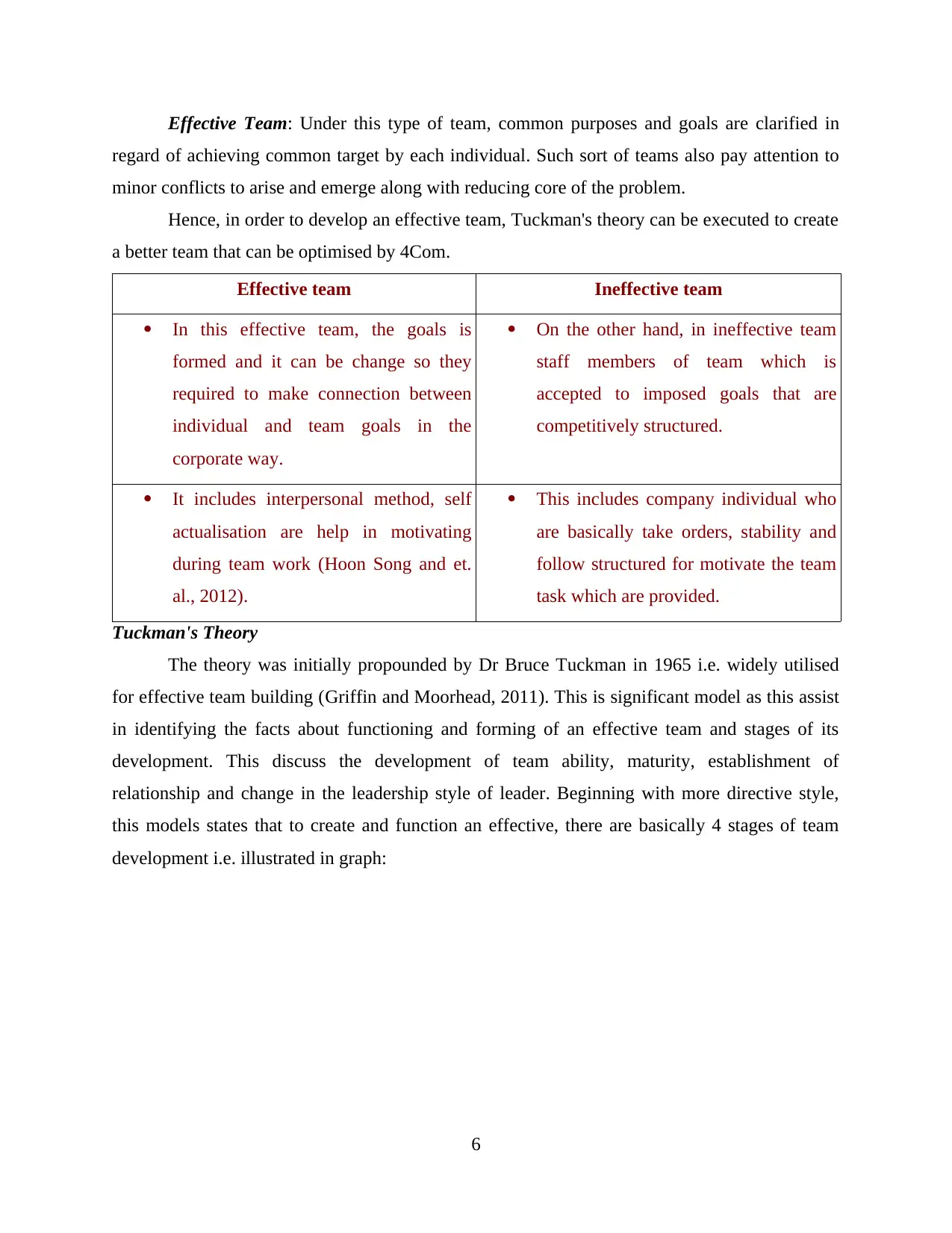
Effective Team: Under this type of team, common purposes and goals are clarified in
regard of achieving common target by each individual. Such sort of teams also pay attention to
minor conflicts to arise and emerge along with reducing core of the problem.
Hence, in order to develop an effective team, Tuckman's theory can be executed to create
a better team that can be optimised by 4Com.
Effective team Ineffective team
In this effective team, the goals is
formed and it can be change so they
required to make connection between
individual and team goals in the
corporate way.
On the other hand, in ineffective team
staff members of team which is
accepted to imposed goals that are
competitively structured.
It includes interpersonal method, self
actualisation are help in motivating
during team work (Hoon Song and et.
al., 2012).
This includes company individual who
are basically take orders, stability and
follow structured for motivate the team
task which are provided.
Tuckman's Theory
The theory was initially propounded by Dr Bruce Tuckman in 1965 i.e. widely utilised
for effective team building (Griffin and Moorhead, 2011). This is significant model as this assist
in identifying the facts about functioning and forming of an effective team and stages of its
development. This discuss the development of team ability, maturity, establishment of
relationship and change in the leadership style of leader. Beginning with more directive style,
this models states that to create and function an effective, there are basically 4 stages of team
development i.e. illustrated in graph:
6
regard of achieving common target by each individual. Such sort of teams also pay attention to
minor conflicts to arise and emerge along with reducing core of the problem.
Hence, in order to develop an effective team, Tuckman's theory can be executed to create
a better team that can be optimised by 4Com.
Effective team Ineffective team
In this effective team, the goals is
formed and it can be change so they
required to make connection between
individual and team goals in the
corporate way.
On the other hand, in ineffective team
staff members of team which is
accepted to imposed goals that are
competitively structured.
It includes interpersonal method, self
actualisation are help in motivating
during team work (Hoon Song and et.
al., 2012).
This includes company individual who
are basically take orders, stability and
follow structured for motivate the team
task which are provided.
Tuckman's Theory
The theory was initially propounded by Dr Bruce Tuckman in 1965 i.e. widely utilised
for effective team building (Griffin and Moorhead, 2011). This is significant model as this assist
in identifying the facts about functioning and forming of an effective team and stages of its
development. This discuss the development of team ability, maturity, establishment of
relationship and change in the leadership style of leader. Beginning with more directive style,
this models states that to create and function an effective, there are basically 4 stages of team
development i.e. illustrated in graph:
6
⊘ This is a preview!⊘
Do you want full access?
Subscribe today to unlock all pages.

Trusted by 1+ million students worldwide
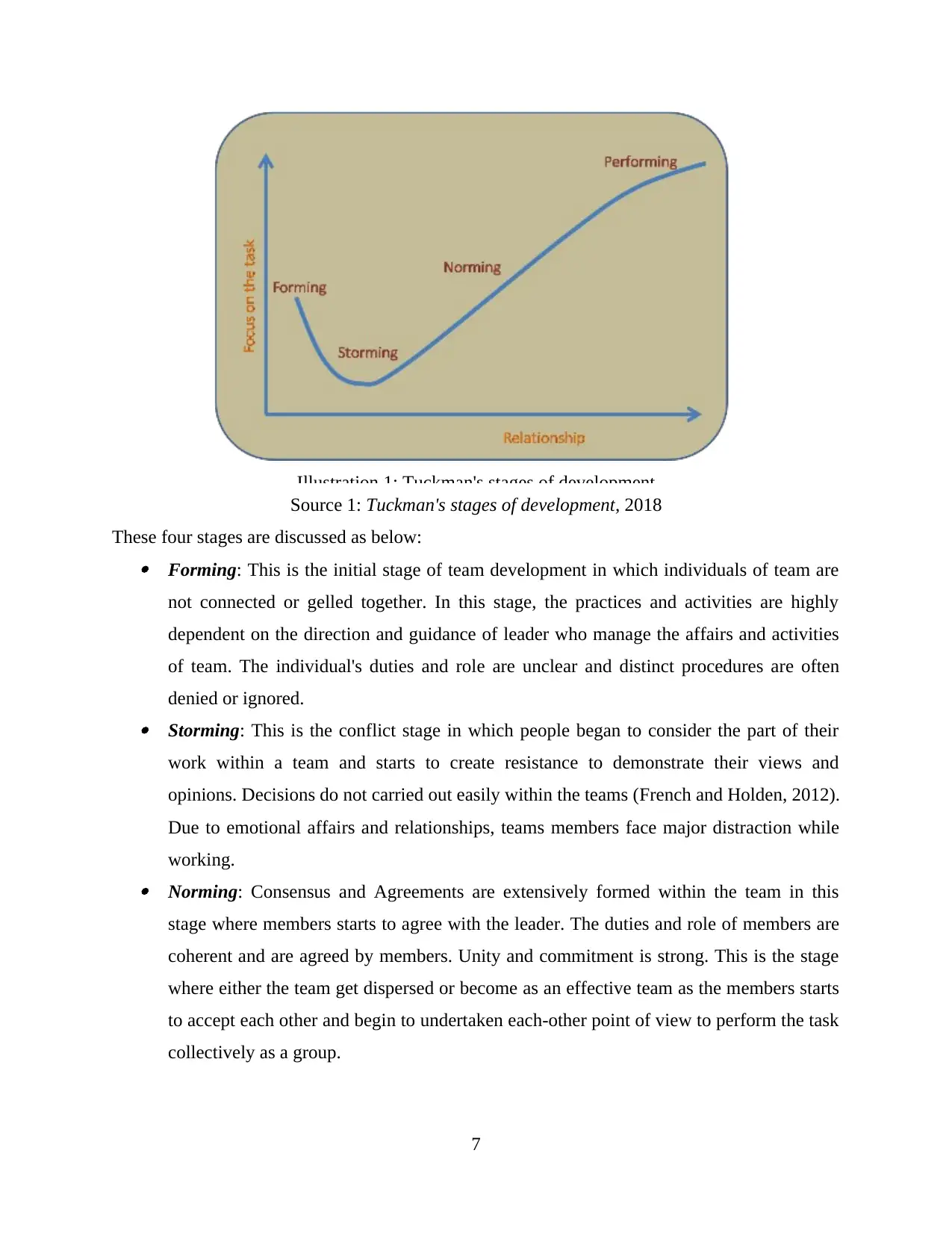
Source 1: Tuckman's stages of development, 2018
These four stages are discussed as below: Forming: This is the initial stage of team development in which individuals of team are
not connected or gelled together. In this stage, the practices and activities are highly
dependent on the direction and guidance of leader who manage the affairs and activities
of team. The individual's duties and role are unclear and distinct procedures are often
denied or ignored. Storming: This is the conflict stage in which people began to consider the part of their
work within a team and starts to create resistance to demonstrate their views and
opinions. Decisions do not carried out easily within the teams (French and Holden, 2012).
Due to emotional affairs and relationships, teams members face major distraction while
working. Norming: Consensus and Agreements are extensively formed within the team in this
stage where members starts to agree with the leader. The duties and role of members are
coherent and are agreed by members. Unity and commitment is strong. This is the stage
where either the team get dispersed or become as an effective team as the members starts
to accept each other and begin to undertaken each-other point of view to perform the task
collectively as a group.
7
Illustration 1: Tuckman's stages of development
These four stages are discussed as below: Forming: This is the initial stage of team development in which individuals of team are
not connected or gelled together. In this stage, the practices and activities are highly
dependent on the direction and guidance of leader who manage the affairs and activities
of team. The individual's duties and role are unclear and distinct procedures are often
denied or ignored. Storming: This is the conflict stage in which people began to consider the part of their
work within a team and starts to create resistance to demonstrate their views and
opinions. Decisions do not carried out easily within the teams (French and Holden, 2012).
Due to emotional affairs and relationships, teams members face major distraction while
working. Norming: Consensus and Agreements are extensively formed within the team in this
stage where members starts to agree with the leader. The duties and role of members are
coherent and are agreed by members. Unity and commitment is strong. This is the stage
where either the team get dispersed or become as an effective team as the members starts
to accept each other and begin to undertaken each-other point of view to perform the task
collectively as a group.
7
Illustration 1: Tuckman's stages of development
Paraphrase This Document
Need a fresh take? Get an instant paraphrase of this document with our AI Paraphraser
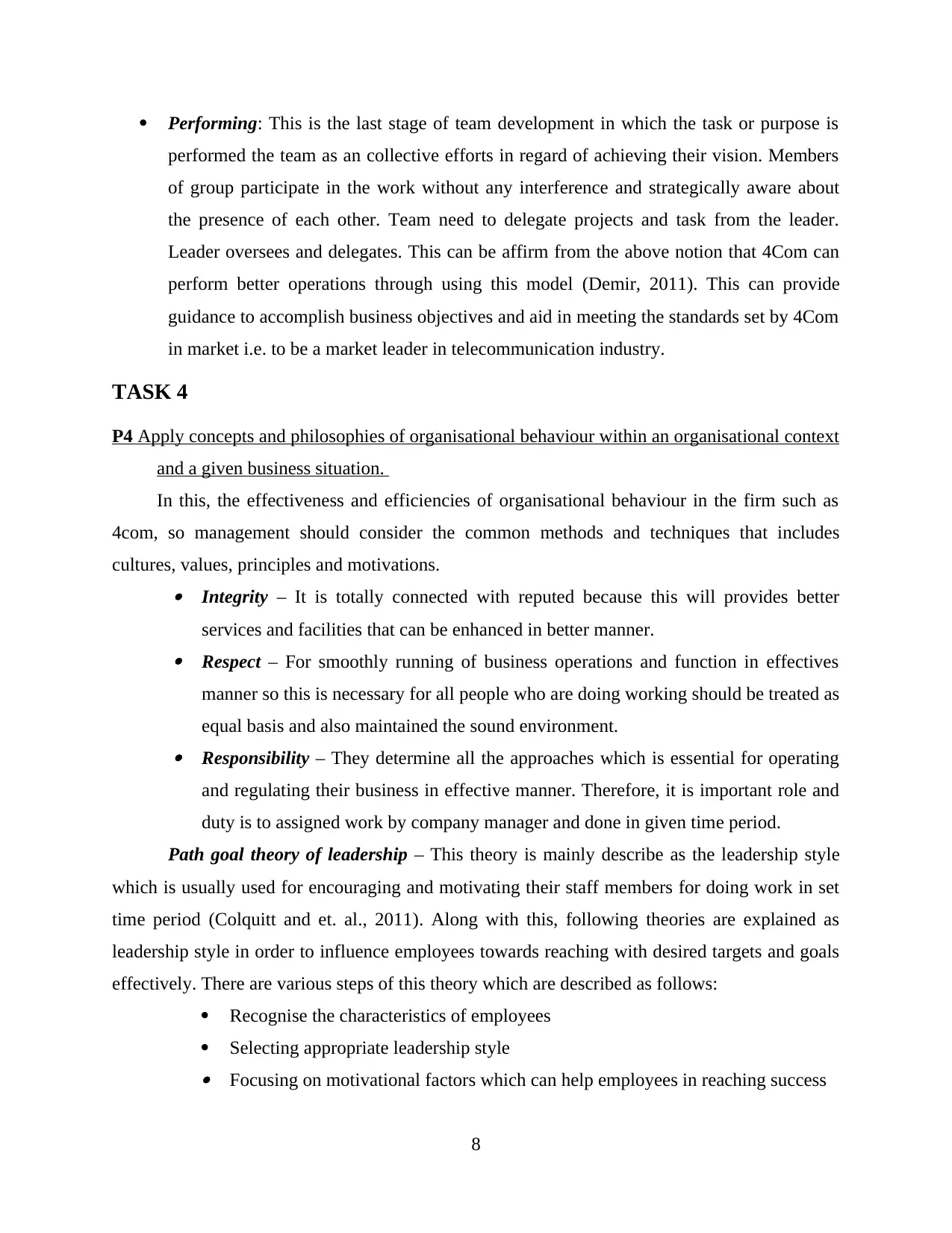
Performing: This is the last stage of team development in which the task or purpose is
performed the team as an collective efforts in regard of achieving their vision. Members
of group participate in the work without any interference and strategically aware about
the presence of each other. Team need to delegate projects and task from the leader.
Leader oversees and delegates. This can be affirm from the above notion that 4Com can
perform better operations through using this model (Demir, 2011). This can provide
guidance to accomplish business objectives and aid in meeting the standards set by 4Com
in market i.e. to be a market leader in telecommunication industry.
TASK 4
P4 Apply concepts and philosophies of organisational behaviour within an organisational context
and a given business situation.
In this, the effectiveness and efficiencies of organisational behaviour in the firm such as
4com, so management should consider the common methods and techniques that includes
cultures, values, principles and motivations.
Integrity – It is totally connected with reputed because this will provides better
services and facilities that can be enhanced in better manner.
Respect – For smoothly running of business operations and function in effectives
manner so this is necessary for all people who are doing working should be treated as
equal basis and also maintained the sound environment.
Responsibility – They determine all the approaches which is essential for operating
and regulating their business in effective manner. Therefore, it is important role and
duty is to assigned work by company manager and done in given time period.
Path goal theory of leadership – This theory is mainly describe as the leadership style
which is usually used for encouraging and motivating their staff members for doing work in set
time period (Colquitt and et. al., 2011). Along with this, following theories are explained as
leadership style in order to influence employees towards reaching with desired targets and goals
effectively. There are various steps of this theory which are described as follows:
Recognise the characteristics of employees
Selecting appropriate leadership style
Focusing on motivational factors which can help employees in reaching success
8
performed the team as an collective efforts in regard of achieving their vision. Members
of group participate in the work without any interference and strategically aware about
the presence of each other. Team need to delegate projects and task from the leader.
Leader oversees and delegates. This can be affirm from the above notion that 4Com can
perform better operations through using this model (Demir, 2011). This can provide
guidance to accomplish business objectives and aid in meeting the standards set by 4Com
in market i.e. to be a market leader in telecommunication industry.
TASK 4
P4 Apply concepts and philosophies of organisational behaviour within an organisational context
and a given business situation.
In this, the effectiveness and efficiencies of organisational behaviour in the firm such as
4com, so management should consider the common methods and techniques that includes
cultures, values, principles and motivations.
Integrity – It is totally connected with reputed because this will provides better
services and facilities that can be enhanced in better manner.
Respect – For smoothly running of business operations and function in effectives
manner so this is necessary for all people who are doing working should be treated as
equal basis and also maintained the sound environment.
Responsibility – They determine all the approaches which is essential for operating
and regulating their business in effective manner. Therefore, it is important role and
duty is to assigned work by company manager and done in given time period.
Path goal theory of leadership – This theory is mainly describe as the leadership style
which is usually used for encouraging and motivating their staff members for doing work in set
time period (Colquitt and et. al., 2011). Along with this, following theories are explained as
leadership style in order to influence employees towards reaching with desired targets and goals
effectively. There are various steps of this theory which are described as follows:
Recognise the characteristics of employees
Selecting appropriate leadership style
Focusing on motivational factors which can help employees in reaching success
8
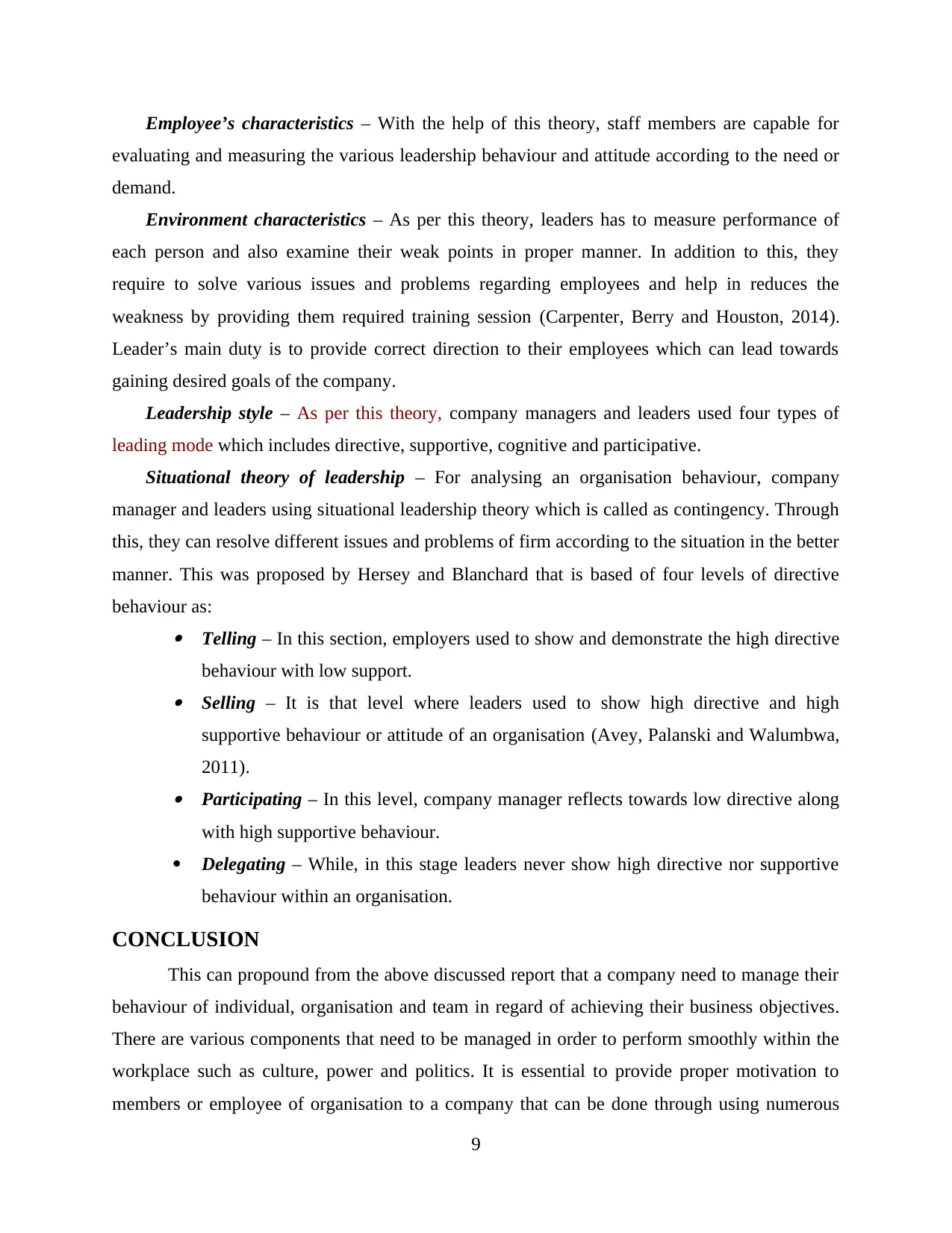
Employee’s characteristics – With the help of this theory, staff members are capable for
evaluating and measuring the various leadership behaviour and attitude according to the need or
demand.
Environment characteristics – As per this theory, leaders has to measure performance of
each person and also examine their weak points in proper manner. In addition to this, they
require to solve various issues and problems regarding employees and help in reduces the
weakness by providing them required training session (Carpenter, Berry and Houston, 2014).
Leader’s main duty is to provide correct direction to their employees which can lead towards
gaining desired goals of the company.
Leadership style – As per this theory, company managers and leaders used four types of
leading mode which includes directive, supportive, cognitive and participative.
Situational theory of leadership – For analysing an organisation behaviour, company
manager and leaders using situational leadership theory which is called as contingency. Through
this, they can resolve different issues and problems of firm according to the situation in the better
manner. This was proposed by Hersey and Blanchard that is based of four levels of directive
behaviour as:
Telling – In this section, employers used to show and demonstrate the high directive
behaviour with low support.
Selling – It is that level where leaders used to show high directive and high
supportive behaviour or attitude of an organisation (Avey, Palanski and Walumbwa,
2011).
Participating – In this level, company manager reflects towards low directive along
with high supportive behaviour.
Delegating – While, in this stage leaders never show high directive nor supportive
behaviour within an organisation.
CONCLUSION
This can propound from the above discussed report that a company need to manage their
behaviour of individual, organisation and team in regard of achieving their business objectives.
There are various components that need to be managed in order to perform smoothly within the
workplace such as culture, power and politics. It is essential to provide proper motivation to
members or employee of organisation to a company that can be done through using numerous
9
evaluating and measuring the various leadership behaviour and attitude according to the need or
demand.
Environment characteristics – As per this theory, leaders has to measure performance of
each person and also examine their weak points in proper manner. In addition to this, they
require to solve various issues and problems regarding employees and help in reduces the
weakness by providing them required training session (Carpenter, Berry and Houston, 2014).
Leader’s main duty is to provide correct direction to their employees which can lead towards
gaining desired goals of the company.
Leadership style – As per this theory, company managers and leaders used four types of
leading mode which includes directive, supportive, cognitive and participative.
Situational theory of leadership – For analysing an organisation behaviour, company
manager and leaders using situational leadership theory which is called as contingency. Through
this, they can resolve different issues and problems of firm according to the situation in the better
manner. This was proposed by Hersey and Blanchard that is based of four levels of directive
behaviour as:
Telling – In this section, employers used to show and demonstrate the high directive
behaviour with low support.
Selling – It is that level where leaders used to show high directive and high
supportive behaviour or attitude of an organisation (Avey, Palanski and Walumbwa,
2011).
Participating – In this level, company manager reflects towards low directive along
with high supportive behaviour.
Delegating – While, in this stage leaders never show high directive nor supportive
behaviour within an organisation.
CONCLUSION
This can propound from the above discussed report that a company need to manage their
behaviour of individual, organisation and team in regard of achieving their business objectives.
There are various components that need to be managed in order to perform smoothly within the
workplace such as culture, power and politics. It is essential to provide proper motivation to
members or employee of organisation to a company that can be done through using numerous
9
⊘ This is a preview!⊘
Do you want full access?
Subscribe today to unlock all pages.

Trusted by 1+ million students worldwide
1 out of 15
Related Documents
Your All-in-One AI-Powered Toolkit for Academic Success.
+13062052269
info@desklib.com
Available 24*7 on WhatsApp / Email
![[object Object]](/_next/static/media/star-bottom.7253800d.svg)
Unlock your academic potential
Copyright © 2020–2025 A2Z Services. All Rights Reserved. Developed and managed by ZUCOL.





